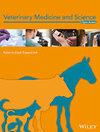加纳库马西选定屠宰场和屠宰板中的蜱虫和蜱传病原体
IF 1.8
3区 农林科学
Q2 VETERINARY SCIENCES
引用次数: 0
摘要
背景蜱虫是影响动物和人类健康的病原体载体。本研究旨在确定屠宰场和屠宰板上蜱虫物种的多样性,并确定这些蜱虫携带的病原体。方法从屠宰的牛身上收集蜱虫,使用 PCR 和测序技术对其进行鉴定和病原体筛查:库马西屠宰场(288 只,77.63%)、阿克瓦蒂亚屠宰场(52 只,14.02%)和苏阿梅屠宰场(31 只,8.35%)。蜱虫的主要种类是Amblyomma variegatum(85.44%),而Rhipicephalus sanguineus (s.l.)(0.27%)是出现最少的种类。根据克里米亚-刚果出血热病毒(CCHFV)基因组 S 段的核蛋白基因区,对蜱池的总核酸进行了病原体筛选、根据克里米亚-刚果出血热病毒(CCHFV)基因组 S 段的核蛋白基因区、烧伤柯西氏杆菌 IS1111a 基因的转座酶基因的 295 bp 片段、巴贝斯虫和泰勒虫的 ssrRNA 基因的 560 bp 片段、埃立克次体属 16SrRNA 基因的 345 bp 片段和立克次体的 rOmpA 基因(OmpA)筛选病原体。在筛查的 52 个蜱池中,有 40 个(76.92%)发现病原体 DNA 呈阳性。鉴定出的病原体有非洲立克次体(69.23%)、艾氏立克次体(7.69%)、烧伤蜱(5.77%)、未培养的埃里希氏菌(5.77%)、线粒体敌敌畏(3.85%)和CCHFV(3.85%)。在 A. variegatum、Hyalomma rufipes、Hyalomma truncatum 与蜱传病原体 R. africae、R. aeschlimannii 和未培养的 Ehrlichia sp.之间观察到明显的关联(p < 0.001)。有必要在屠宰场内采取控制措施,防止病原体传播。本文章由计算机程序翻译,如有差异,请以英文原文为准。
Ticks and tick‐borne pathogens in selected abattoirs and a slaughter slab in Kumasi, Ghana
BackgroundTicks are vectors of pathogens that affect the health of animals and humans. With the constant trade of livestock across borders, there is the risk of new tick species invasion accompanied by the spread of infectious tick‐borne pathogens.AimThis study sought to determine the diversity of tick species within abattoirs and a slaughter slab as well as identify the pathogens carried by these ticks.MethodsThe ticks were collected from slaughtered cattle, identified and screened for pathogens using PCR and sequencing.ResultsA total of 371 ticks were collected from slaughtered cattle across the three sampling sites: Kumasi abattoir (288, 77.63%), Akwatia Line slaughter slab (52, 14.02%) and Suame abattoir (31, 8.35%). The predominant species was Amblyomma variegatum (85.44%) with Rhipicephalus sanguineus (s.l.) (0.27%) as the least occurring species. Total nucleic acid from the tick pools was screened for pathogens based on the nucleoprotein gene region in the S segment of the Crimean–Congo haemorrhagic fever virus (CCHFV) genome, the 295‐bp fragment of the transposase gene of the Coxiella burnetii IS1111a element, the 560 bp segment of the ssrRNA gene of Babesia and Theileria , the 345 bp fragment of the Ehrlichia genus 16SrRNA gene and the rOmpA gene (OmpA) of Rickettsia . From the 52 tick pools screened, 40 (76.92%) were found positive for pathogen DNA. The pathogens identified were Rickettsia africae (69.23%), Rickettsia aeschlimannii (7.69%), C. burnetii (5.77%), uncultured Ehrlichia sp. (5.77%), Candidatus Midichloria mitochondrii (3.85%) and CCHFV (3.85%). A significant association was observed among A. variegatum , Hyalomma rufipes , Hyalomma truncatum and occurring tick‐borne pathogens R. africae , R. aeschlimannii and uncultured Ehrlichia sp. (p < 0.001).ConclusionThe findings show the occurrence of zoonotic pathogens, suggesting an increased risk of infections among the abattoir workers. There is a need to adopt control measures within the abattoirs to prevent pathogen spread.
求助全文
通过发布文献求助,成功后即可免费获取论文全文。
去求助
来源期刊

Veterinary Medicine and Science
Veterinary-General Veterinary
CiteScore
3.00
自引率
0.00%
发文量
296
期刊介绍:
Veterinary Medicine and Science is the peer-reviewed journal for rapid dissemination of research in all areas of veterinary medicine and science. The journal aims to serve the research community by providing a vehicle for authors wishing to publish interesting and high quality work in both fundamental and clinical veterinary medicine and science.
Veterinary Medicine and Science publishes original research articles, systematic reviews, meta-analyses, and research methods papers, along with invited editorials and commentaries. Original research papers must report well-conducted research with conclusions supported by the data presented in the paper.
We aim to be a truly global forum for high-quality research in veterinary medicine and science, and believe that the best research should be published and made widely accessible as quickly as possible. Veterinary Medicine and Science publishes papers submitted directly to the journal and those referred from a select group of prestigious journals published by Wiley-Blackwell.
Veterinary Medicine and Science is a Wiley Open Access journal, one of a new series of peer-reviewed titles publishing quality research with speed and efficiency. For further information visit the Wiley Open Access website.
 求助内容:
求助内容: 应助结果提醒方式:
应助结果提醒方式:


